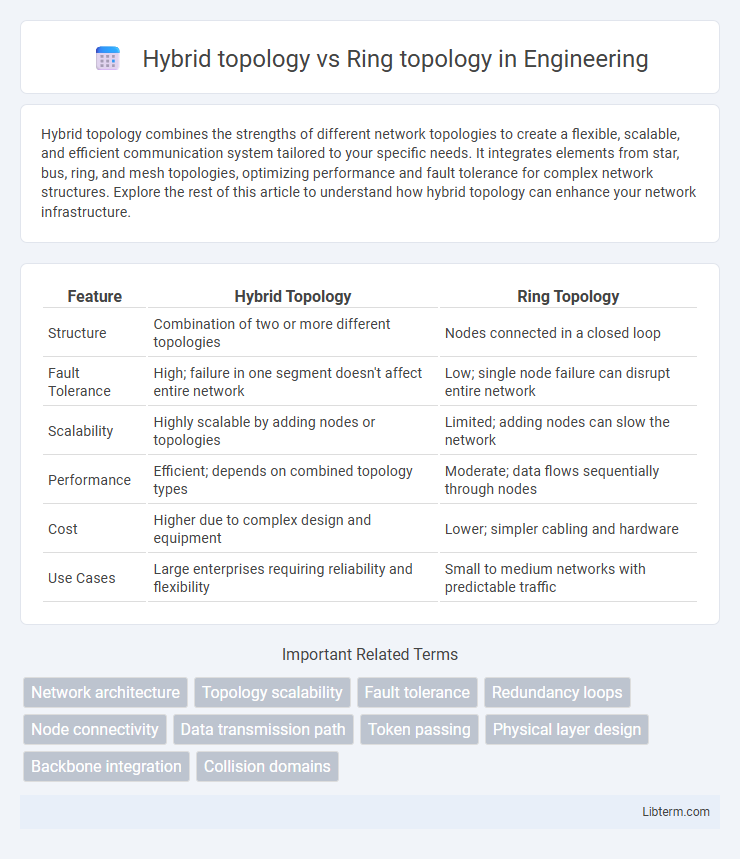Hybrid topology combines the strengths of different network topologies to create a flexible, scalable, and efficient communication system tailored to your specific needs. It integrates elements from star, bus, ring, and mesh topologies, optimizing performance and fault tolerance for complex network structures. Explore the rest of this article to understand how hybrid topology can enhance your network infrastructure.
Table of Comparison
| Feature | Hybrid Topology | Ring Topology |
|---|---|---|
| Structure | Combination of two or more different topologies | Nodes connected in a closed loop |
| Fault Tolerance | High; failure in one segment doesn't affect entire network | Low; single node failure can disrupt entire network |
| Scalability | Highly scalable by adding nodes or topologies | Limited; adding nodes can slow the network |
| Performance | Efficient; depends on combined topology types | Moderate; data flows sequentially through nodes |
| Cost | Higher due to complex design and equipment | Lower; simpler cabling and hardware |
| Use Cases | Large enterprises requiring reliability and flexibility | Small to medium networks with predictable traffic |
Introduction to Network Topologies
Hybrid topology combines multiple network topologies, such as star, bus, and ring, to leverage the strengths of each, enhancing network flexibility and efficiency. Ring topology connects devices in a circular sequence, where data travels in one direction, ensuring equal access but potentially causing delays if one node fails. Understanding these topologies is crucial for designing robust and scalable networks that meet specific organizational needs.
What is Ring Topology?
Ring topology connects each device to exactly two other devices, forming a circular data path that facilitates predictable data transmission and minimizes packet collisions. Data travels in one direction, passing through each device until reaching the intended recipient, which enhances fault isolation but can cause network failure if a single device or connection breaks. This contrasts with hybrid topology, which combines multiple topologies to improve flexibility and fault tolerance beyond the limitations of a simple ring setup.
What is Hybrid Topology?
Hybrid topology combines two or more different network topologies, such as star, ring, or bus, to leverage the strengths and minimize the weaknesses of each. It offers enhanced flexibility, scalability, and fault tolerance compared to a singular ring topology, which connects devices in a circular sequence allowing data to travel in one or both directions. Hybrid topology is ideal for complex networks requiring adaptability and optimal performance across diverse environments.
Architecture and Structure Comparison
Hybrid topology combines multiple network topologies such as star, bus, and ring, allowing flexible and scalable architecture designed for complex network environments. Ring topology features a circular structure where each device connects to exactly two other devices, forming a closed loop that supports predictable data flow and reduces transmission collisions. While hybrid topology enhances fault tolerance and can isolate network segments to prevent widespread failure, ring topology's simplicity enables efficient data transmission but may suffer from downtime if a single connection breaks.
Performance and Scalability
Hybrid topology offers superior performance and scalability by combining the strengths of multiple topologies, allowing networks to efficiently handle increased traffic and expand without significant degradation. Ring topology delivers consistent, predictable data transmission speeds but faces challenges in scalability due to its sequential data path and potential single points of failure. Networks requiring flexible growth and high performance under varied loads benefit more from hybrid topologies compared to the fixed structure of ring topologies.
Fault Tolerance and Reliability
Hybrid topology combines the strengths of multiple network structures, offering superior fault tolerance by isolating failures within specific segments without impacting the entire system. Ring topology relies on a circular data path; a single point of failure can disrupt the entire network unless dual rings or fault-tolerant mechanisms like self-healing protocols are implemented. Consequently, hybrid topology generally provides higher reliability and resilience in complex network environments compared to traditional ring configurations.
Cost and Implementation Complexity
Hybrid topology typically incurs higher costs due to the integration of multiple network types and requires more complex implementation involving diverse hardware and configuration processes. Ring topology offers a cost-effective solution with lower implementation complexity, relying on a straightforward, closed-loop design that simplifies troubleshooting and expansion. The increased flexibility and scalability of hybrid topology come at the expense of both budget and setup time compared to the more uniform and predictable ring topology.
Use Cases and Applications
Hybrid topology combines the strengths of multiple topologies, making it ideal for large-scale enterprise networks requiring scalable, fault-tolerant environments such as data centers and campus networks. Ring topology suits applications demanding predictable data transmission and easy fault isolation, commonly used in metropolitan area networks (MANs) and fiber optic networks for telecommunications. Hybrid networks offer flexibility for complex systems, while ring networks excel in environments with linear or circular layouts needing consistent data flow and minimal collision.
Pros and Cons of Ring Topology
Ring topology offers advantages like easy fault isolation and consistent data flow due to its unidirectional or bidirectional ring structure, which minimizes data collisions. However, its main drawback is that a single node or connection failure can disrupt the entire network unless a dual ring or fault tolerance mechanisms are implemented. Maintenance and scalability are also challenging compared to hybrid topology, which combines multiple topologies for greater flexibility and reliability.
Advantages and Limitations of Hybrid Topology
Hybrid topology combines the strengths of multiple network topologies, offering enhanced flexibility, scalability, and fault tolerance compared to ring topology, which relies on a single continuous loop. The advantages of hybrid topology include improved performance through segment isolation, easier fault isolation, and adaptability to various network sizes and requirements. However, hybrid topology can be more complex to design and maintain, with higher implementation costs due to the integration of different topological structures.
Hybrid topology Infographic

 libterm.com
libterm.com